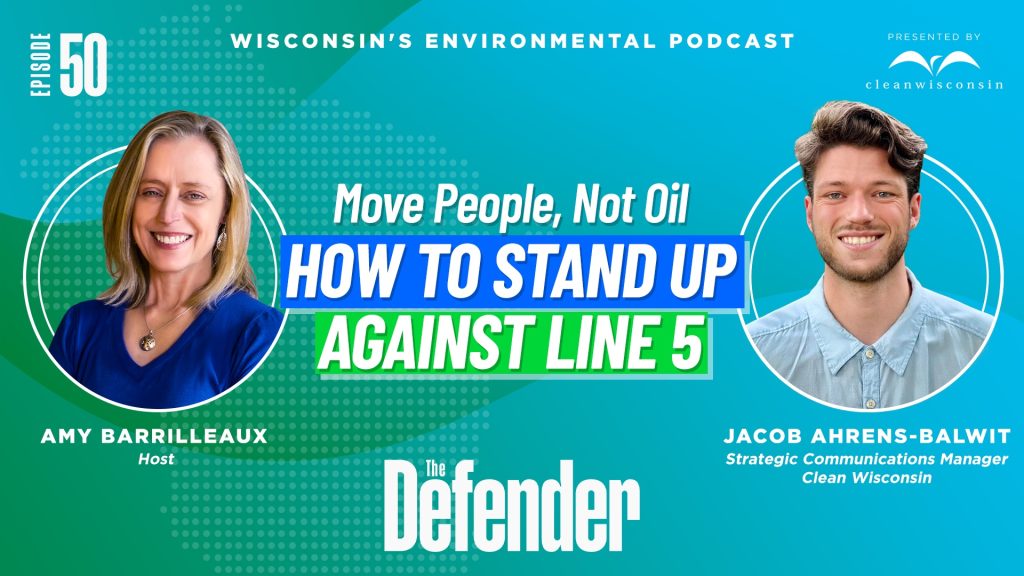Where to Listen:
In the long, never-ending struggle to protect our environment, it can be easy to feel helpless, powerless. Maybe nothing underscores that feeling more than trying to stop a big foreign oil interest from building a pipeline across your state. But there is something you can do to speak out against the Line 5 oil pipeline. And it’s fun! Amy looks at the Move People Not Oil campaign.
Host:
Amy Barrilleaux
Guest:
Clean Wisconsin strategic communications manager Jacob Ahrens-Balwit
Resources for You:
Enbridge Line 5 Blasting Area Photos (Instagram)
Move People Not Oil – Take the pledge and more information
Transcript:
Amy Hello and welcome to the Defender, Wisconsin’s environmental podcast. I’m Amy Barrilleaux. The Defender is powered by Clean Wisconsin, your environmental voice since 1970. In the long, never-ending struggle to protect our environment, it can be easy to feel helpless, powerless. Maybe nothing underscores that feeling more than trying to stop a big foreign oil interest from building a pipeline across your state. But there is something you can do to speak out against the Line 5 oil pipeline. And it’s fun! A look at the Move People Not Oil campaign right now on The Defender. Later this month, testimony gets underway in legal action to stop a reroute of the Line 5 oil pipeline. Canadian oil giant Enbridge wants to blast and trench its way across 41.1 miles of northern Wisconsin forests and wetlands to build a new section of the pipeline that will help move oil extracted from the Canadian tar sands in Alberta to refineries in Ontario. Clean Wisconsin is involved in legal actions to stop construction, but for most of us who are not attorneys on the case, it’s hard to know how to help. There is a way you can help draw attention to the water resources being put at risk by this pipeline. Joining me is Clean Wisconsin strategic communications manager Jacob Ahrens-Balwit. Jacob, thank you for being here.
Jacob Thanks for having me, Amy.
Amy So you’re here to talk about the Move People Not Oil campaign. So what is that about?
Jacob So the Move People Not Oil campaign, it’s a month-long challenge where anyone can walk, run, bike, paddle, swim, or move however they would like to move to log 41.1 miles in August of this year. And that’s the same distance as the proposed reroute that Enbridge is trying to push through in northern Wisconsin. So it’s the symbolic way for people to show support for clean water and stand in solidarity with the communities that are most impacted by the reroute of Line 5.
Amy Why is it important for, I guess, symbolism right now? Because we’re not attorneys, you and me anyway and most folks, we’re in the day-to-day battle against this pipeline. So why is it important for people just to kind of show their feeling about what’s going on?
Jacob Well, the bottom line is that Wisconsin has strong water protections, and Enbridge’s proposal fails to meet those strong standards that Wisconsin has, and we are saying that no company, no matter how big, no matter how well-resourced that company is, they should not get a free pass to pollute our water. And this symbolic action, moving people, not oil, for that same distance that Enbridge is trying to reroute their pipeline. Is a way of showing that we have people power behind us. For the Army Corps of Engineers public comment period, there were about 150,000 commenters from across the country that used their voice to show opposition to Enbridge’s proposal. So we’re hoping to have a massive turnout for this action as well, and really engage more people in this fight against Line 5.
Amy Why is it important, I guess, for people to know what’s going on? Because Line 5 and this 41.1 mile reroute is up in northern Wisconsin. So, you know, not a place that we really see every day all across the state. And many people may not even realize what’s, what’s going on. So is the hope kind of like, this is going to grab people’s attention at a time when they’re already, you know, maybe hoping to head outdoors?
Jacob Absolutely and you know our hope is for this to be a very accessible challenge. We want people to feel comfortable moving however they move normally. You can log your miles in the gym, you can log you’re miles on a walk, you can your miles while you’re paddle boarding or canoeing or biking or running. So really you don’t have to go out of your way to participate in this challenge. You can do this with a group, you could do this by yourself. We have a Strava club set up, so you can just search Strava for stop, or excuse me, for move people not oil and participate in the challenge that way. You can log your miles however you would like to. The most important thing is that you just go to cleanwisconsin.org/move and you sign the pledge that you will move 41.1 miles in August. And every mile that we log will help show support for clean water, support for tribal sovereignty. And support for the community is most impacted by the proposed reroute of Line 5.
Amy And so this is, as we get into how this challenge works, it’s also kind of important to share this with your friends and your family and maybe your social media connections that, hey, I’m doing this, I moving 41.1 miles and this means something, this is about something.
Jacob Absolutely. You know, I listen to The Daily podcast most mornings and it seems like there’s an ad for Enbridge in that podcast pretty regularly. Enbridge is the kind of company that has a lot of money. They’ve got a lot resources and frankly they do a pretty good job of getting their message out. We don’t have those same resources on our side of this fight. So that’s why it’s so important to use the people power that we’re generating with a challenge like this to try to spread the message. And we don’t have a massive advertising budget, but what we do have is people who are moving their bodies and sharing their stories on social media. They’re sending us emails with pictures and their routes and they’re engaging on the Strava group. So the more that people can not only take the pledge, and do the challenge, but participate in it and be active online and share it with their community the farther that this action is going to be able to go.
Amy So you talked about this Strava app, which I think is some kind of an app that helps you kind of display or get in groups to display your, you know, biking or your running or any kind of physical challenge that you may be participating in. So what exactly is this? It’s not like an official Clean Wisconsin’s hosting a bike ride. It’s more kind of like, hey, take the pledge, take a challenge to move 41 miles and 41.1 miles. And really get the word out about this awful project that could be happening in northern Wisconsin.
Jacob Exactly. And again, you can log your miles, however works best for you. The nice thing about our Strava group is we’re going to be putting our group rides on there. So for instance, every single Wednesday through the course of August at 6 p.m., we partnered with Motorless Motion, the bike shop on West Washington Avenue in Madison, Wisconsin, and they are going to be hosting a group ride that will be about 10 miles per week, totaling 41.1 miles over the course of the month of August. And as a little bonus, after the ride, you can return to motorless motion and get reduced prices on tacos, at Bandit Tacos afterwards. So there are some community events that we are organizing on Strava, but it’s another place where you can log your miles, share the routes that you’ve been doing and engage with our community there.
Amy And I know you are a pretty active canoer and hiker and biker and all those things. The outdoors are really important to you. Is that kind of what sparked an interest in doing this kind of movement challenge to support legal action and awareness about Line 5?
Jacob Yeah, yeah. And, you know, northern Wisconsin is a is a really special place to me and frankly, it’s a really place to anybody that has ever gone up there. It’s so clear that these pristine habitats, these very fragile ecosystems up there are better without having dynamite blasted through them. And when you’re talking about a 41.1 mile section of northern Wisconsin that’s being trenched and truly destroyed so that a company can continue to move their oil products across our state, you know, it just seems like such a such a contrast to have people moving their bodies and using their energy over that same distance to show that a better way is possible. I think that if we get enough people to participate in this challenge, it will send a very strong message that the public stands with strong water protections, strong environmental protections, and with the bad river band.
Amy I know we were looking at some photographs of northern Wisconsin that Enbridge had entered into testimony, the areas where they will be blasting to make way for line five if this legal challenge isn’t successful. And you had a pretty strong reaction to those photos. I’m hoping that we’ll have them up soon after this podcast goes out. But you’ve lived in Wisconsin your whole life. This whole state and its environment is so incredibly important to you. What went through your mind when you saw those photographs of the places that were going to be totally changed if this pipeline goes through.
Jacob You know, in our conversations with our attorneys who are working on the case, they’ve mentioned that Enbridge says that they can basically return those habitats to their natural state. And when I see those photos of a healthy, thriving ecosystem in Northern Wisconsin. Knowing that the plan is to blast those areas with dynamite, trench them, and put in a new oil pipeline there, I think it would fill anybody with a sense of loss. Because the truth is, you can’t return these natural ecosystems that have been the product of natural phenomena for millennia back to their natural state after you. Blast through them like Enbridge is proposing to do here. I would say that fills me and and and anybody else who would look at them with an open mind with a real sense of loss.
Amy For folks who are listening to this, maybe they’re not big bikers and hikers and canoers but want to do something, how would you advise them to get involved?
Jacob Well, the co-founder of Clean Wisconsin, Doug LaFollette, our former Secretary of State in Wisconsin, he’s in his 80s and still walks a couple miles every day. You can often see him walking around on the east side of Madison. And Doug has taken the pledge to move his body 41.1 miles. So this isn’t a challenge that’s just for athletes or just for people who, you know, go on long bike rides, or take long hikes, or go on canoe trips down the Wisconsin River. This is really for everybody, and we can all commit to walking just a little bit more than one mile a day. It’s good for you, it’s good for the environment, and it’s good for the shared future that we all want to have.
Amy Jacob, thank you so much for talking with me about this and for your work putting this all together. I’m really excited about the challenge and I’m gonna figure out if I’m going to bike or walk or do some kind of combination, but definitely gonna get there. So thank you.
Jacob Thank you, Amy, I look forward to seeing you out there.
Amy And thank you for listening to the Defender podcast. We have photos of some of the areas that Enbridge wants to blast to make way for the Line 5 pipeline. You can find a link in the show notes. And again, to take the pledge and sign up for the Move People Not Oil campaign, head to cleanwisconsin.org/move. I’m Amy Barrilleaux, talk to you later.





